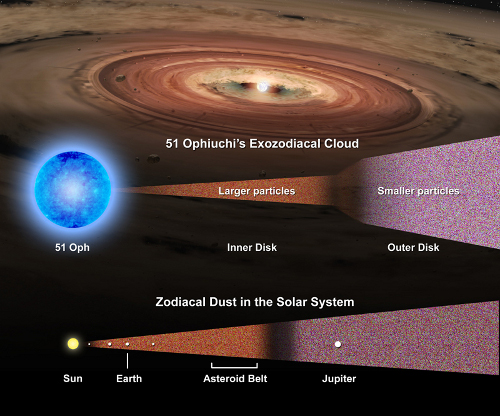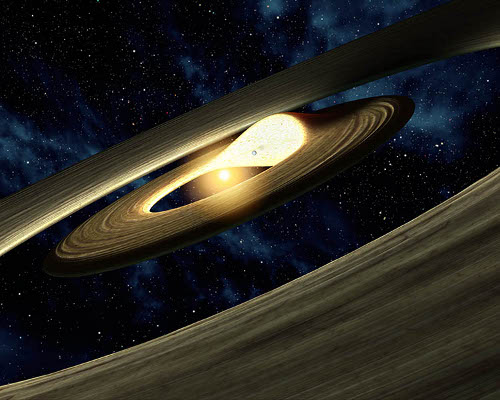Protoplanetary disks may not raise the same level of excitement that the discovery of new planets does, but to me, the idea of watching a planetary system form is awe-inspiring. I can’t help but wonder whether, going back about five billion years or so, astronomers around some distant star weren’t watching the early signs of planetary formation around our own star. Disks in their various stages give us a sense of the continuity of solar system development.
Continuity, that is, in the sense that stars seem to form planets as a matter of course. But we’re seeing yet more evidence this week that protoplanetary disks can vary markedly from star to star. Now comes news of the dust cloud around 51 Ophiuchi, which turns out to be not one but two distinct disks, an inner one with grains 10 micrometers and larger in diameter (based on infrared observations), and an outer one made up of primarily 0.1 micrometer grains.

Image: This graphic compares the inner and outer disk of the 51 Ophiuchi system to the location of the planets and asteroid belt of the Solar System. Credit: NASA/GSFC/Marc Kuchner and Francis Reddy.
The inner disk around this B-class star extends out to four AU and is considered one of the most compact such disks ever detected. The outer disk goes from seven AU out to about 1200 AU. In similar systems, inner and outer clouds are distinct, but 51 Ophiuchi, some 260 times more luminous than the Sun, offers up a change of pace. Here the disks seem to be connected, with the system having only a single belt of asteroids. Is this an infant system entering the late stages of planet building? Are terrestrial planets forming in the stellar haze?
Whatever the case, there is a lot of dust here. Christopher Stark (NASA GSFC) describes it this way:
“Our study shows that 51 Ophiuchi’s disk is more than 100,000 times denser than the zodiacal dust in the solar system. This suggests that the system is still relatively young, with many colliding bodies producing vast amounts of dust.”
Interesting work, and a study that takes advantage of the Keck Observatory’s interferometry capabilities to make high resolution measurements equal to a telescope as large as the distance between the primary mirrors involved, some 85 meters. The interferometer’s Nuller was then used to block direct starlight from the star, allowing the dust cloud to be measured to great precision. Observations from other instruments helped to fill out the picture.
We also got word this week of the unusual behavior of the disk around the young star LRLL 31, whose light has been seen to vary in as little time as a single week. One possibility here is the presence of a planet close to the star, which could be causing the planet-forming material to vary in thickness as it orbits the star.
James Muzerolle and team (Space Telescope Science Institute) are behind this one, having set about to study the IC 348 star-forming region in the constellation Perseus. These are young stars, about two to three million years old and some 1000 light years from Earth. Working with the Spitzer instrument, the team found changes to the light from the inner region of the system disk. Spitzer has shown that the disk has both an inner and an outer gap. Says Kevin Flaherty (UA, Tucson), “Transition disks are rare enough, so to see one with this type of variability is really exciting.”
Adds Elise Furlan (JPL):
“A companion in the gap of an almost edge-on disk would periodically change the height of the inner disk rim as it circles around the star: a higher rim would emit more light at shorter wavelengths because it is larger and hot, but at the same time, the high rim would shadow the cool material of the outer disk, causing a decrease in the longer-wavelength light. A low rim would do the opposite. This is exactly what we observe in our data.”

Image: An artist’s conception of LRLL 31. The data show that infrared light from the disk is changing over as little time as one week — a very unusual occurrence. In particular, light of different wavelengths seesawed back and forth, with short-wavelength light going up when long-wavelength light went down, and vice versa. According to astronomers, this change could be caused by a companion to the star (illustrated as a planet in this picture). As the companion spins around, its gravity would cause the wall of the inner disk to squeeze into a lump. This lump would also spin around the star, shadowing part of the outer disk. When the bright side of the lump is on the far side of the star, and facing Earth, more infrared light at shorter wavelengths should be observed (hotter material closer to the star emits shorter wavelengths of infrared light). In addition, the shadow of the lump should cause longer-wavelength infrared light from the outer disk to decrease. The opposite would be true when the lump is in front of the star and its bright side is hidden (shorter-wavelength light would go down, and longer-wavelength light up). This is precisely what Spitzer observed. Credit: NASA/JPL-Caltech/R. Hurt (SSC).
Fascinating stuff, and we’ll know more as astronomers follow up with ground-based telescopes. The paper on LRLL 31 will run in the Astrophysical Journal Letters; for now, a news release is available. The paper on the Keck work is Stark et al., “51 Ophiuchus: A Possible Beta Pictoris Analog Measured with the Keck Interferometer Nuller,” Astrophysical Journal 703 (2009), pp. 1188-1197 (abstract). A preprint is available.



This star is of spectral class B, and yet it seems likely based on the information presented here that it has a planet forming disk. What implications does this have for the often heard contention that planet formation around solar type and smaller stars is seriously impeded in OB associations? In other words, planet formation must be an extreme robust process if we are now finding examples of it occuring literally right around the huge, bright, seething, blue B type stars? Who else feels me on this?
Hi Folks;
It is interesting to contemplate that we may be in the position to visualize and image new solar systems forming that may one day evolve ETI species and civilizations. In a sense, we are older brothers and sisters to any such would be ETI persons.
The reality that 51 Ophiuchi seems to be developing a solar system has ramification as to whether or not life could develope on any future worlds around the star as life seems to have gotten an early foothold on Earth.
I would think that due to potentially harsh environmental chemistry and thermodynamics on planets around such highly luminous stars that it would be hard for life to develop on any such planets that would be DNA based.
Anyhow, the rich set of protoplanetary systems that is becoming all the more evident gives one room to ponder the exotic and even bazaar forms of bodily ETI that might evolve on any associated planets.
51 Ophiuchi is a “B” blue star. Its not going to last long enough to allow our kind of life to evolve on any planets around it, let alone develop the ophiuchi hotline. Also, the larger particle ring (where presumably the terrestrial planets go) is way too hot for life to form. The outer ring structure is far enough out for the HZ. This dust ring will make one hell of an asteroid belt, though.
Oh, the spectral output of 51 Ophiuchi is shifted towards the UV and X-ray end of the spectrum, which is not so nice for life either. Still, you can make space colonies out of that dust cloud, assuming you have proper shielding for those UV and X-rays.
The planet formation processes around intermediate-mass and high-mass stars are an interesting challenge for observations, as the radial velocity techniques are not so effective (for intermediate-mass stars you typically have to take stars in the subgiant or giant star phases of their evolution to get decent radial velocities). I wonder if the planets formed in this environment have any chemical peculiarities arising from needing the disc to be stabilised against the star’s high ultraviolet radiation levels: one way of doing this is to have lots of carbon-rich material in the disc.
Even before pluto was labelled a dwarf planet, I know that there were reasons it shouldnt be a planet. As a youth I noticed that the first 8 planets were all generally on the same plane, but pluto was greatly skewed – this led me to believe that the 8 planets were formed from some original disc, and pluto got captured by gravity.
i seem to be correct about that, but i wonder how common an event it is for the near planets to be terrestrial rocky worlds, and the more distant planets to be gas giants.
Clumps in the Outer Disk by Disk Instability: Why They are Initially Gas Giants and the Legacy of Disruption
Authors: Aaron C. Boley, Tristen Hayfield, Lucio Mayer, Richard H. Durisen
(Submitted on 24 Sep 2009)
Abstract: We explore the initial conditions for fragments in the extended regions (r>50 AU) of gravitationally unstable disks. We combine analytic estimates for the fragmentation of spiral arms with 3D SPH simulations to show that initial fragment masses are in the gas giant regime. These initial fragments will have substantial angular momentum, and should form disks with radii of a few AU.
We show that clumps will survive for multiple orbits before they undergo rapid collapse due to H2 dissociation and that it is possible to destroy bound clumps by transporting them into the inner disk. The consequences of disrupted clumps for planet formation, dust processing, and disk evolution are discussed.
We find that it is possible to produce Earth-mass cores in the outer disk during the earliest phases of disk evolution.
Comments: Submitted to Icarus
Subjects: Earth and Planetary Astrophysics (astro-ph.EP)
Cite as: arXiv:0909.4543v1 [astro-ph.EP]
Submission history
From: Aaron Boley [view email]
[v1] Thu, 24 Sep 2009 20:35:25 GMT (432kb,D)
http://arxiv.org/abs/0909.4543
Dirty Stars Make Great Hosts for New Dirty Stars Make Great Hosts for New Worlds
Dirty stars — those rich in heavier elements — make the best hosts of planetary systems, new research suggests. Dirty stars — those rich in heavier elements — make the best hosts of planetary systems, new research suggests.
http://www.space.com/scienceastronomy/091007-dirty-stars.html
Collision probabilities of migrating small bodies and dust particles with planets
Authors: S.I. Ipatov
(Submitted on 16 Oct 2009)
Abstract: Probabilities of collisions of migrating small bodies and dust particles produced by these bodies with planets were studied. Various Jupiter-family comets, Halley-type comets, long-period comets, trans-Neptunian objects, and asteroids were considered.
The total probability of collisions of any considered body or particle with all planets did not exceed 0.2. The amount of water delivered from outside of Jupiter’s orbit to the Earth during the formation of the giant planets could exceed the amount of water in Earth’s oceans.
The ratio of the mass of water delivered to a planet by Jupiter-family comets or Halley-type comets to the mass of the planet can be greater for Mars, Venus, and Mercury, than that for Earth.
Comments: 7 pages (original paper consists of 4 pages, with all sub-figures on one page). Proceedings of the IAU Symposium 263 “Icy bodies in the Solar System” (Rio de Janeiro, Brazil, 3-7 August, 2009), ed. by D. Lazzaro, D. Prialnik, R. Schulz, J.A. Fernandez, submitted
Subjects: Earth and Planetary Astrophysics (astro-ph.EP)
Cite as: arXiv:0910.3017v1 [astro-ph.EP]
Submission history
From: Sergei Ipatov [view email]
[v1] Fri, 16 Oct 2009 01:44:00 GMT (33kb)
http://arxiv.org/abs/0910.3017